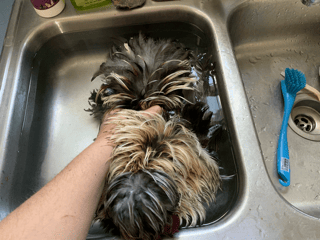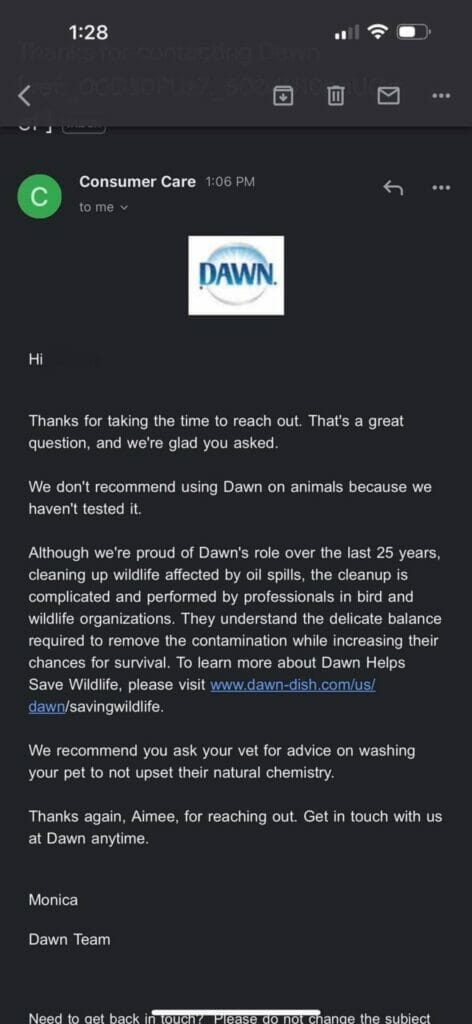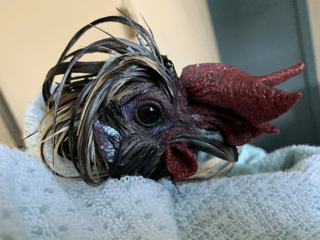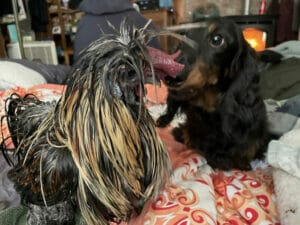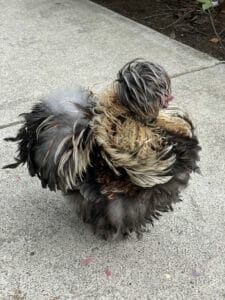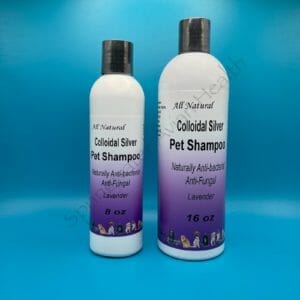When, Why and How to Bathe Your Chicken
Sometimes a chicken needs to be bathed. Reasons for needing bathing include external parasite infestation, messy eating (especially cross/scissor beak birds that eat mash), after an injury, cleaning up vent gleet, messy bums or for show. Overall chickens tolerate bathing fairly well if you keep their comfort in mind.
Washing
Draw up a warm bath, depth of midway up the birds chest if sitting, not as warm as you would like, but a bit warmer than lukewarm, a temperature you would use for a human infant is good. Set your bird gently in the water and wet them down using a cup for pouring water, a sink sprayer or my favorite, Waterpik’s Pet Wand Pro. Keep water away from their eyes, nostrils and beak. If you need to clean up these areas use a washcloth the dampen the area and a soft toothbrush works well to gently clean soiled areas under the beak. You do not want your bird taking in bathwater as the could aspirate.
Once your birds feathers are saturated with water you want to use a product that doesn’t strip them of all their oil. I will place drops of shampoo down the birds back and a few on the tail and gently work it in, you want to work it in with motion following the growth of the feathers to not damage them. For the underside I will apply shampoo to my hands and then stand the bird up and work the shampoo in on the chest, belly and down the legs. Don’t forget to apply a bit near the vent and clean that area also! For the legs you can use a toothbrush or soft nail brush to clean the scaly part or the leg, their foot pad, toes and nails.
At Springwater Avian Health we carry my favorite shampoo for birds, made by fellow small business, Healthline Nutrition in Vancouver, Washington, Lavender Colloidal Silver Shampoo. This shampoo contains calming lavender oil, a safe EO for use with birds (many, in fact most EO’s are not bird safe), multiple oils including; coconut oil, jojoba oil, olive oil and grape seed oil which help clean but not leave their feathers dull and stripped of oils. This shampoo is light in texture, much like a cream rinse, and is easy to rinse out which makes bathing so much easier! I have also found that this shampoo does an excellent job when it comes to external parasites along with a treatment such as Spinosad after your bird is dry.
**USE OF DAWN AS A SHAMPOO**
When people talk about washing birds the use of Dawn often comes up. Dawn is not a shampoo or soap, it is a detergent. Dawn strips all oils from your birds skin and feathers, as this is the nature of a detergent. Shampoos and soaps are made with oils and they clean you or your animal but leave oil behind so skin is not left unprotected and dry, and with birds, feathers are not left stripped of the oils they need to function properly. Dawn is used by trained wildlife rescuers on birds that have been exposed to oil in oil spill disasters. This oil from spills must be removed from the bird to save their life and a detergent is what is needed to strip off the oil. After the bird is stripped of oil they are retained buy the rescuers, often for several weeks, while the birds preen and their natural oils are restored to their skin and feathers. If the rescuers released the birds right after being washed with dawn they would not have protection from the elements, waterfowl will die if let out in the wild with no natural oil on their feathers. We emailed Dawn/PG about the use of Dawn to wash peoples birds and pets, here is their reply.
Rinsing
After the shampoo is worked in you will need to give your bird a good rinse. This process can be done with cups of warm water, with the sprayer in your kitchen sink or the fabulous Waterpik Pet Wand I linked above. As with the bath water, make sure the water is not to cold, yet not to warm, like a baby’s bath water. I usually start at the neck/chest and work my way to the tail/vent, making sure I do not get water in my birds eyes, nostrils or mouth. If you need to rinse a crested bird, it is possible to use a gentle spray holding their head at the right angle but the bird must trust you. If they do not cooperate then use a washcloth with clean water to “rinse” the area, a washcloth is also good for the face, under the beak, comb and wattles. Once the shampoo is rinsed out you are ready to dry your bird.
Drying
Have a clean, dry towel ready to wrap them in. First thing I do is use my hands running down their back and in the direction of feather growth to remove excess water. Next I wrap them in the waiting dry towel and pat them down removing more excess water. Lastly I blow dry them which most chickens love!! You can use a home blow dryer on low, keeping a safe distance for moderate temperature, to dry them. Another option, which a lot of people who show use, is a Pet Grooming Dryer which has adjustable speed, temperature and different nozzles you can apply to the output hose to really target the areas needing drying. If you wash your birds frequently these are definitely worth the investment.
If it is a warm and sunny day you do have the option after a good towel drying of letting nature finish up the job but that will depend on the bird. A show bird you won’t want to let out onto the ground till after the show. House and disabled birds may not even go outside at all.
Important! Make sure your chicken is completely dry if the weather is cold or if the bath was due to external parasites or wounds! When they are wet they can not properly regulate their body temperature.
Finishing Touches
After being dried you can shine up your birds comb, wattles and legs with a healthy oil like jojoba or a product like Vet Rx. This is common practice for show grooming and often repeated the day of the show. Its also nice just for some moisturizer and maybe a fun photoshoot of your pet.
Other grooming tasks that follow a bath are often nail, spur and beak trimming which will be covered in a future article.
Additional information
Healthline Nutrition Lavender Colloidal Silver Shampoo has so many great benefits. If you are bathing your bird because of injury the colloidal silver will help sanitize wounds, and of course this shampoo is great for any skin concerns as its very soothing with antibacterial and anti fungal properties. If you have a bird with vent gleet or kidney problems it is also a great product for cleaning up yeasty areas or areas with crate deposits. You don’t want either sitting on your birds skin, causing more irritation.
We do not recommend using DAWN despite it being advertised as safe for birds. Dawn is technically bird safe but it also strips all the oil from their feathers and skin! Its claim to fame and still an excellent use is cleaning up birds that have been involved in crude oil/ petroleum disasters, which is a situation you want Dawns oil stripping properties as you don’t want crude oil/petroleum left on the bird.
If you are grooming for show you will want to bathe a couple days before the show so your bird has time to preen their feathers before the day of the event to apply oil from their preening gland and get their feathers back in proper shape.
Bathing your chicken can be a pleasant task with the right preparation! It might even be a good bonding activity between you and your bird.
